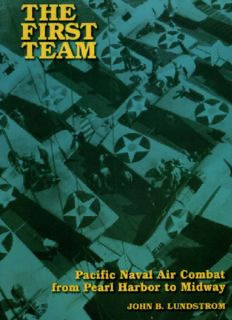
The First Team : Pacific Naval Air Combat from Pearl Harbor to Midway PDF
Preview The First Team : Pacific Naval Air Combat from Pearl Harbor to Midway
The First Team THE FIRST TEAM Pacific Naval Air Combat from Pearl Harbor to Midway By John B. Lundstrom Naval Institute Press Annapolis, Maryland Naval Institute Press 291 Wood Road Annapolis, MD 21402 © 1984 by the United States Naval Institute Reprinted with updates and corrections 1990 All rights reserved. No part of this book may be reproduced or utilized in any form or by any means, electronic or mechanical, including photocopying and recording, or by any information storage and retrieval system, without permission in writing from the publisher. First Naval Institute Press paperback edition, 2005 ISBN 13: 978-1-61251-166-5 The Library of Congress has cataloged the hardcover edition as follows: Lundstrom, John B. The first team. Bibliography: p. Includes index. 1. World War, 1939–1945—Aerial operations, American. 2. World War, 1939–1945—Naval operations, American. 3. World War, 1939–1945—Campaigns—Pacific Ocean. I. Title. D790.L8 1984 940.54′4973 84-9822 12 11 10 09 9 8 7 6 5 4 Dedicated to the memory of Bernard Lundstrom, my father and Roger M. Rice, my brother-in-law and friend Contents Foreword Preface Acknowledgments Special Note Abbreviations and Special Terms PART I The Early Operations 1 Introduction to War The Fighting Squadrons: Missions, Men, and Aircraft AIR RAID ON PEARL HARBOR X THIS IS NO DRILL Pearl Harbor Aftermath The Sara to the Front 2 “We are in great need of a victory.” The Wake Island Operation Initial Moves The Disappointment 3 Interregnum The Weeks of Futility The Samoan Operation—The Yorktown to the Pacific 4 “This Sunday it’s our turn to shoot!” The 1 February Raids Approach to Battle Task Force 8 in the Marshalls The Yorktown’s Strikes Return to Pearl 5 The Battle off Bougainville: Fighting Three in the South Pacific 6 The Enterprise’s Central Pacific Raids Return to Wake Island A Visit to Marcus 7 The Lae–Salamaua Raid Gathering the Forces A Change of Targets Withdrawal and the Lexington Home 8 The Tokyo Raid Preliminaries—Introducing the Grumman F4F-4 Wildcat The Advent of Fighting Eight Six Hundred Miles from Tokyo PART II The Battle of the Coral Sea 9 Prelude to Battle The Yorktown in the Coral Sea, March–April 1942 Fighting Two to the South Pacific 10 Opening Shots Coral Sea Preliminaries Tulagi Strike Gathering Storm: 5–6 May in the Coral Sea The Inscrutable Enemy 11 7 May 1942 The Battle off Misima Afternoon Reassessment The Japanese Dusk Attack 12 The Carrier Battle of 8 May The Searches The Attack on MO Striking Force “Hey Rube”—The Attack on Task Force 17 Return of the Strike Groups The Loss of the Lex 13 Coral Sea Aftermath “We are all short of oil, running like hell.” Task Force 16’s Anabasis to the South Pacific “Desire you proceed to the Hawaiian area.” Coral Sea Combat Lessons PART III The Battle of Midway 14 Getting Ready for Midway The Reorganization of Fighting Three The Carriers in Port Midway—The Waiting 15 The Battle of 4 June The Opening Moves The Attack on Nagumo’s Carriers The Japanese Retaliate Retribution Summary for 4 June 16 Midway—The Pursuit 5–6 June off Midway The Loss of the Yorktown The Sara Back to the Front “How good land will look this time” 17 The “First Team” Graduates 18 Midway Lessons—The F4F-4 Controversy PART IV Conclusion Appendixes 1 The Making of Carrier Fighter Pilots U.S. Naval Flight Training Japanese Naval Flight Training 2 Fundamentals of Aerial Fixed Gunnery 3 Fighting Colors, Insignia, and Markings 4 Naval Flight Formations and the “Thach Weave” 5 Japanese Combat Methods 6 List of U.S. Navy Fighter Pilots 7 Bureau Numbers of Fighter Aircraft Notes Sources Index Foreword The wit and comradery that the British muster so well in uncomfortable circumstances sparkles in a ditty made up by Royal New Zealand Air Force types to honor the USS Yorktown (CV-5) at a trying time of her existence. Our flattop had put in at Tonga Tabu’s out-of-the-way anchorage so divers could check the extent of underwater damage received in the Coral Sea battle. As an added layer of security for the ship during this delicate operation, some of us of her air group were temporarily based ashore in readiness to launch from a nearby meadow that served as an airfield. We listened in good heart as the serenade went on extolling that “fine tidy ship.” We were pleasantly surprised that here were spontaneous sentiments that matched so well our private feelings for our stout ship, our “home plate” in fighter director lingo. Bruised but not bested, she was as clean and hearty as we could make her. There was plenty of fight left in that high-stepping girl. The divers determined that with some innovative patching she could fight some more—and she would! By the time of this visit to Tonga Tabu, Yorktowners’ impression of the war and their part in it was beginning to pall. Clearly, Japan was taking over in the western Pacific. The Yorktown and the Lexington had presented the only serious opposition to Imperial plans. Their assignment was simple: react, try to stop the most serious advances. The reactive role, aside from its built-in perils, is depressing and, over a period of time, is mighty rough on the good-humor program, especially with no end in sight. The Japanese were winning, and they seemed to be tireless. When the Lexington, after several weeks’ absence, rejoined us in our own piece of the Coral Sea, our spirits leaped only to dive to a new low as we watched her flaming death throes and felt the bone-shattering blast that sent her to the bottom. Still there was pride and plenty of spirit in the Yorktown. We had carried the fight to the foe and had stopped a baleful threat to Australia. We knew great issues depended on our carrying on. There was
Description: